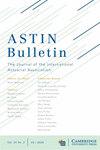基于树的机器学习方法建模和预测死亡率
IF 1.8
3区 经济学
Q2 ECONOMICS
引用次数: 4
摘要
机器学习最近进入了死亡率文献,以改进随机死亡率模型的预测。本文建议使用两种纯粹的、基于树的机器学习模型:随机森林和梯度增强,基于不同的对数死亡率来产生更准确的死亡率预测。将这些预测与传统的随机死亡率模型的预测以及随机森林和随机模型的梯度增强变体的预测进行比较。比较基于模型置信集过程。结果表明,在大多数考虑的情况下,纯的、基于树的模型明显优于所有其他模型。为了解决与机器学习模型相关的缺乏可解释性的问题,我们演示了如何提取基于树的模型所揭示的关系的信息。为此,我们考虑了可变重要性、部分依赖图和可变分裂条件。样本内拟合的结果表明,基于树的模型可以是非常有用的工具,用于检测变量内部和变量之间的模式,这些模式通常无法用传统方法识别。本文章由计算机程序翻译,如有差异,请以英文原文为准。
TREE-BASED MACHINE LEARNING METHODS FOR MODELING AND FORECASTING MORTALITY
Abstract Machine learning has recently entered the mortality literature in order to improve the forecasts of stochastic mortality models. This paper proposes to use two pure, tree-based machine learning models: random forests and gradient boosting, based on the differenced log-mortality rates to produce more accurate mortality forecasts. These forecasts are compared with forecasts from traditional, stochastic mortality models and with forecasts from random forests and gradient boosting variants of the stochastic models. The comparisons are based on the Model Confidence Set procedure. The results show that the pure, tree-based models significantly outperform all other models in the majority of cases considered. To address the lack of interpretability issue associated with machine learning models, we demonstrate how to extract information about the relationships uncovered by the tree-based models. For this purpose, we consider variable importance, partial dependence plots, and variable split conditions. Results from the in-sample fit suggest that tree-based models can be very useful tools for detecting patterns within and between variables that are not commonly identifiable with traditional methods.
求助全文
通过发布文献求助,成功后即可免费获取论文全文。
去求助
来源期刊

ASTIN Bulletin
数学-数学跨学科应用
CiteScore
3.20
自引率
5.30%
发文量
24
审稿时长
>12 weeks
期刊介绍:
ASTIN Bulletin publishes papers that are relevant to any branch of actuarial science and insurance mathematics. Its papers are quantitative and scientific in nature, and draw on theory and methods developed in any branch of the mathematical sciences including actuarial mathematics, statistics, probability, financial mathematics and econometrics.
 求助内容:
求助内容: 应助结果提醒方式:
应助结果提醒方式:


